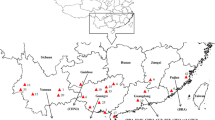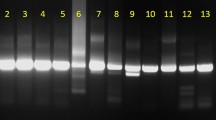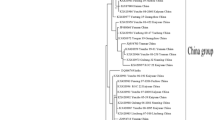Abstract
Thirty sugarcane leaf samples exhibiting midrib yellowing symptoms from nine sugarcane growing states of India were collected. The total RNA was isolated from infected samples and RT-PCR assays were performed using Sugarcane yellow leaf virus (SCYLV) specific primers. The infection of SCYLV was detected in 27 out of 30 samples, which showed the expected size (~610 bp) amplicon during RT-PCR. The amplicons from 13 samples were cloned, sequenced and sequence data of these isolates were analyzed to determine sequence identities, sequence variations and phylogenetic relationships with the SCYLV isolates reported earlier from India and abroad with the view to identify the virus isolates based on partial sequence of ORF5, and complete ORF3 (coat protein, CP) and ORF4 (movement protein, MP). The analysis of the complete sequence data (613 nucleotides) of 13 isolates under study revealed 96–100% identities among them and also with SCYLV-Cuban isolate. The identities were 90–94% with other isolates of SCYLV reported from other countries. The nucleotide (nt) and amino acid (aa) sequence comparison in the CP and MP coding regions showed a significant variation between Indian isolates (SCYLV-IND) and other SCYLV isolates reported worldwide. Phylogenetic analyses of the 13 SCYLV isolates under study showed that they clustered together along with most other SCYLV-Indian isolates and a SCYLV-Cuba isolate. The remaining isolates from other regions of the world and a single isolate from India characterized in a previous study clustered into separate groups. Therefore, the isolates under study were identified as isolates of SCYLV which are closely related to SCYLV-Cuba, the member of ‘CUB’ genotype.


Similar content being viewed by others
References
Abu Ahmad Y, Rassaby L, Royer M (2006a) Yellow leaf of sugarcane is caused by at least three different genotypes of Sugarcane yellow leaf virus, one of which predominates on the Island of Reunion. Arch Virol 151:1355–1371
Abu Ahmad Y, Royer M, Daugrois JH (2006b) Geographical distribution of four Sugarcane yellow leaf virus genotypes. Plant Dis 90:1156–1160
Abu Ahmad Y, Girard JC, Fernandez E, Pauquet J, Lockhart BEL, Letourmy P, Rott P (2007) Variation in virus populations and growth characteristics of two sugarcane cultivars naturally infected by Sugarcane yellow leaf virus in different geographical locations. Plant Pathol 56:743–754
Arocha Y, Lopez M, Fernandez M, Pinol B, Horta D, Peralta EL, Almeida R, Carvajal O, Picornell S, Wilson MR, Jones P (2005) Transmission of a Sugarcane yellow leaf phytoplasma by the delphacid planthopper Saccharosydne saccharivora, a new vector of sugarcane yellow leaf syndrome. Plant Pathol 54:634–642
Comstock JC, Miller JD, Tai PYP, Follis JE (1999) Incidence of and resistance to Sugarcane yellow leaf virus in Florida. Proc Int Soc Sugarcane Technol Cong 23:366–372
Comstock JC, Miller JD, Schnell RJ (2001) Incidence of Sugarcane yellow leaf virus in clones maintained in the world collection of sugarcane and related grasses at the United States National Repository in Miami, Florida. Sugar Tech 3(4):128–133
D’Arey CJ, Domier LL (2005) Luteoviridae. In: Fauquet CM, Mayo MA, Maniloff J, Desselberger U, Ball LA (eds) Virus taxonomy. VIIIth Report of the International Committee on Taxonomy of Viruses. Academic, New York, pp 891–900
Fitch MMM, Lehrer AT, Komor E, Moore PH (2001) Elimination of Sugarcane yellow leaf virus from infected sugarcane plants by meristem tip culture visualized by tissue blot immunoassay. Plant Pathol 50:676–680
Gaur RK (2003) Serological, biochemical and molecular characterization of Sugarcane mosaic virus in India. CSJM Univ., Kanpur, Ph.D. Thesis.
Izaguirre-Mayoral ML, Carballo O, Alceste C, Romano M, Nass HA (2002) Physiological performance of asymptomatic and yellow leaf syndrome-affected sugarcanes in Venezuela. J Phytopathol 150:13–19
Lehrer AT, Kusalwang A, Komar E (2008) High incedence of Sugarcane yellow leaf virus (SCYLV) in sugar plantations and germplasm collections in Thailand. Australas Plant Dis Notes 3:89–92
Lockhart BEL, Cronje CPR (2000) Yellow leaf syndrome. In: Rott P, Bailey RA, Comstock JC, Croft BJ, Saumtally SA (eds) A guide to sugarcane disease. La Librairie du CIRAD, Montpellier, pp 291–295
Maia IG, Gonçalves MC, Arruda P, Vega J (2000) Molecular evidence that sugarcane yellow leaf virus (ScYLV is a member of the Luteoviridae family. Arch Virol 145:1009–1019
Moonan F, Mirkov TE (2002) Analyses of the genotype diversity among North, South, and Central American isolates of Sugarcane yellow leaf virus. Evidence for Colombian origin and for intraspecific spatial phylogenetic variation. J Virol 76:1339–1348
Morgenstern B (1999) DIALIGN 2, improvement of the segment-to-segment approach to multiple sequence alignment. Bioinformatics 15:203–210
Rao GP, Ford RE (2001) Vectors of virus and Phytoplasma diseases of sugarcane-An overview. In: Rao GP, Ford RE, Tosic M, Teakle DS (eds) Sugarcane pathology. II Viral and phytoplasma diseases. Science Publishers Inc., Enfield, pp 265–314
Rao GP, Jain RK, Tosic M, Kristic B, Ford RE (2001) Antigenic diversity, peptide profiling and coat protein sequencing relationship of a virus isolate causing mosaic disease of sugarcane in Uttar Pradesh, India. Proc Int Soc Sugarcane Technol 24:646–647
Rassaby L, Girard JC, Lemaire O, Costet L, Irey MS, Kodja H, Lockhart BEL, Rott P (2004) Spread of Sugarcane yellow leaf virus in sugarcane plants and field on the Island of Reunion. Plant Pathol 53:117–125
Rott P, Comstock JC, Croft BJ, Kusalwong A, Saumtally SA (2005) Advances and challenges in sugarcane pathology. Proc Int Soc Sugarcane Technol Cong 25:607–614
Rott P, Mirkov TE, Schenck S, Girard JC (2008) Recent advances in research on Sugarcane yellow leaf virus, the causal agent of sugarcane yellow leaf. Sugar Cane Int 26:18–22,27.
Scagliusi SM, Lockhart BEL (2000) Transmission, characterization and serology of a luteovirus associated with yellow leaf syndrome of sugarcane. Phytopathology 90:120–124
Schenck S (2001) Sugarcane yellow leaf syndrome: history and current concepts. In: Rao GP, Ford RE, Tosic M, Teakle DS (eds) Sugarcane pathology, Vol II: Virus and phytoplasma disease. Science Publishers Inc, Enfield, pp 25–35
Smith GR, Borg Z, Lockhart BEL, Braithwaite KS, Gibbs MJ (2000) Sugarcane yellow leaf virus: a novel member of the Luteoviridae that probably arose by inter-species recombination. J Gen Virol 81:1865–1869
Tamura K, Dudley J, Nei M, Kumar S (2007) MEGA 4: Molecular Evolutionary Genetics Analysis (MEGA) software version 4.0. Mol Biol Evol 24:1596–1599
Vega J, Scagliusi SMM, Ulian EC (1997) Sugarcane yellow leaf disease in Brazil: evidence of association with a luteovirus. Plant Dis 81:21–26
Viswanathan R (2002) Sugarcane yellow leaf syndrome in India: incidence and effect on yield parameters. Sugar Cane Internt 5:17–23
Viswanathan R, Balamuralikrishan M, Karuppaiah R (2008) Identification of three genotypes of Sugarcane yellow leaf virus causing yellow leaf disease from India and their molecular characterization. Virus Genes 37:368–379
Acknowledgements
The authors wish to express sincere thanks to Director, National Botanical Research Institute, Lucknow for providing facilities for analysis of sequence data. The authors are also thankful to Department of Science and Technology, New Delhi, India for providing financial assistance under WOS-A Scheme during the course of this study.
Author information
Authors and Affiliations
Corresponding author
Rights and permissions
About this article
Cite this article
Singh, D., Rao, G.P., Snehi, S.K. et al. Molecular detection and identification of thirteen isolates of Sugarcane yellow leaf virus associated with sugarcane yellow leaf disease in nine sugarcane growing states of India. Australasian Plant Pathol. 40, 522–528 (2011). https://doi.org/10.1007/s13313-011-0061-y
Received:
Accepted:
Published:
Issue Date:
DOI: https://doi.org/10.1007/s13313-011-0061-y




